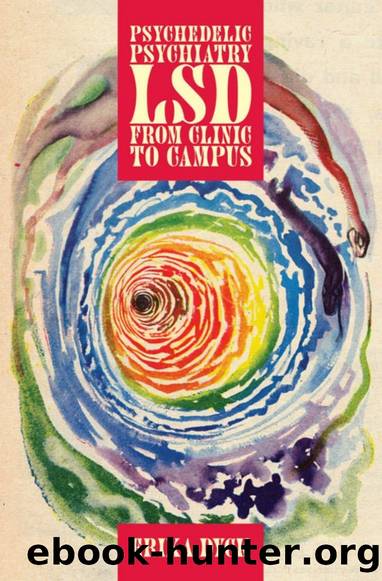Psychedelic Psychiatry: Lsd from Clinic to Campus by Erika Dyck

Author:Erika Dyck [Dyck, Erika]
Language: eng
Format: epub
ISBN: 9780801889943
Amazon: 0801889944
Barnesnoble: 0801889944
Goodreads: 4899275
Publisher: Johns Hopkins Univ Pr
Published: 2008-12-15T06:00:00+00:00
LSD and Youth
After the Second World War, the birth rate in North America rose significantly from interwar levels. The Canadian birth rate increased by nearly 100,000 from its prewar level of 300,000 births per year and continued growing annually from 1945 until peaking in 1959 with a 185 percent increase from prewar levels.7 This population expansion created a significantly large cohort of people who reached adolescence in the period 1965 to 1975: the archetypal baby boomers. Although scholars have debated whether this segment of the population deserves recognition as a cohesive unit, the widespread concerns that arose over drug use in the mid-1960s played upon fears associated with the image of an entire generation getting high and engaging in morally reprehensible activities.8 Regardless of whether this image depicted reality, the very notion galvanized society along generational lines. As a result, the 1960s youth bore the brunt of concerns over the increased use of drugs in the postwar period.
Not all drug consumption precipitated a moral panic. Prescription rates for drugs soared during the 1960s, building upon developments in psychopharmacology from the previous decade. Psychiatry embraced psychopharmacological treatments and introduced a cornucopia of drugs into the mental health care system; many of these drugs went through methodological clinical trials similar to those for LSD. In 1965, for example, prescriptions for amphetamines in the United States reached 24 million, while pharmacies filled 123 million prescriptions for sedatives and tranquilizers in the same year. By 1965, 6.5 million American women had prescriptions for the oral contraceptive, the pill. Middle-class house wives, allegedly suffering from âa problem that had no name,â constituted a large group of drug users, making drugs such as Miltown (meprobamate) and Valium into popular house hold items.9
These drugs also captured popular cultural attention. American talk show host Milton Berle jokingly called himself âMiltown Berle.â The British rock group the Rolling Stones sang about âsuburban house wives who could not tolerate the mind-numbing tedium of kitchen and kids without resorting to âmoth-erâs little helpersâ [Miltown].â North Americans readily used chemical substances during the postwar period, making the subsequent condemnation of young peopleâs experiments with drugs somewhat inconsistent.10
But in the case of prescription drugs, an identifiable and established cohort of society was the predominant consumerâpatients with mental illnesses, middle-class house wives, or women of child-bearing years. These groups, however, did not raise the specter that their drug use (and indeed abuse in some cases) constituted a threat to the moral order. Similarly, the fact that men regularly engaged in alcohol consumption did not arouse panic that the male-dominated rituals would evoke a bond among men that would subsequently threaten to overthrow normal society.11 Indeed, in the case of patients with mental illnesses and women, despite campaigns aimed at politicizing their identity in society, either as consumer survivors or as feminists, their drug-taking activities had a minimal effect, if any, on public perceptions of their group identity.12 In stark contrast, the under-thirty generation assumed a threatening position in society and their drug-taking activities allegedly united them in a common desire to get high and change societal values.
Download
This site does not store any files on its server. We only index and link to content provided by other sites. Please contact the content providers to delete copyright contents if any and email us, we'll remove relevant links or contents immediately.
| Administration & Medicine Economics | Allied Health Professions |
| Basic Sciences | Dentistry |
| History | Medical Informatics |
| Medicine | Nursing |
| Pharmacology | Psychology |
| Research | Veterinary Medicine |
The Immortal Life of Henrietta Lacks by Rebecca Skloot(4525)
An American Plague by Jim Murphy(3708)
The Emperor of All Maladies: A Biography of Cancer by Siddhartha Mukherjee(3063)
The Gene: An Intimate History by Siddhartha Mukherjee(3047)
The Fate of Rome: Climate, Disease, and the End of an Empire (The Princeton History of the Ancient World) by Kyle Harper(3003)
Rebecca Skloot by The Immortal Life of Henrietta Lacks(1977)
Stiff - The Curious Lives of Human Cadavers by Mary Roach(1812)
The Great Influenza by John M Barry(1750)
The Vaccine Race by Meredith Wadman(1627)
Undue Risk by Moreno Jonathan D.;(1600)
Hero by Michael Grant(1584)
Three Cups of Tea by Greg Mortenson(1576)
The Mystery of the Exploding Teeth by Thomas Morris(1539)
Quackery by Lydia Kang(1518)
Autism's False Prophets by Paul A. Offit(1495)
Extremes: Life, Death and the Limits of the Human Body by Fong Kevin(1483)
A Journal of the Plague Year (Oxford World's Classics) by Daniel Defoe(1480)
Steroids: History, Science, and Issues by Standora Joan E.; Bogomolnik Alex; Slugocki Malgorzata(1479)
The Vaccine Court by Rohde Wayne(1469)
